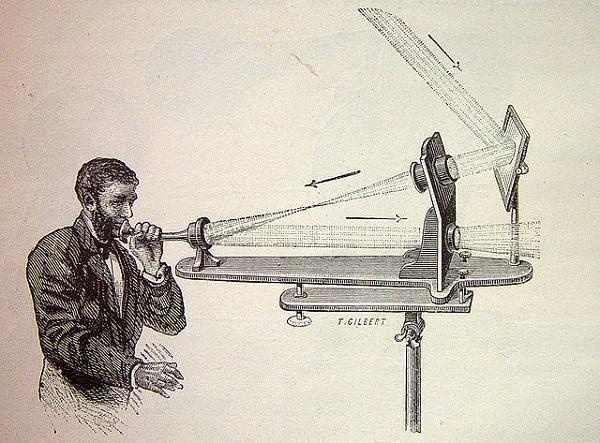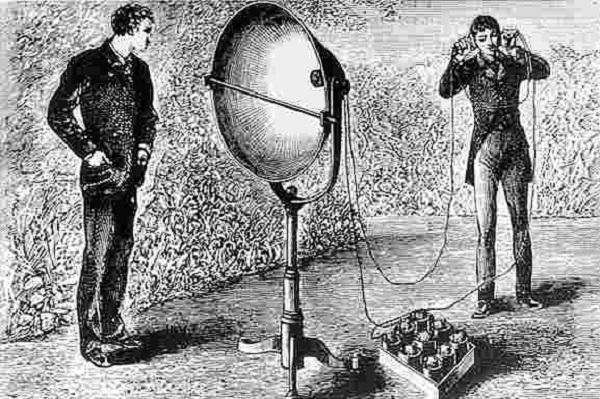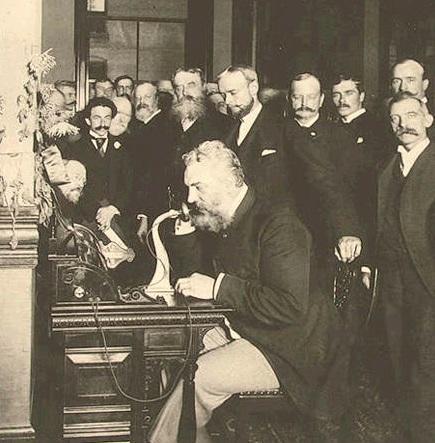Note: the image above is the famous photograph of Alexander Graham Bell making the first long-distance telephone call from New York to Chicago in 1892
A Brief Biography of Alexander Graham Bell
Alexander Graham Bell, born on March 3, 1847 in Edinburgh, Scotland, was an inventor and educator, best known for his invention of the telephone. Bell descended from a family of speech pathologists and was fascinated by sound from a young age. He invented a “speaking machine” in his teens and was encouraged by his father to study and experiment with anything electrical, including telegraph technology. Bell studied at the University of Edinburgh and University of London and became his father’s assistant. He taught the deaf to talk by adopting his father’s system of Visible Speech.
From 1873 to 1876, Bell spent his days teaching hearing-impaired children and his evenings experimenting with sound. The funds for his scientific experiments came from the fathers of two of his students. Bell’s knowledge of the physiology of human speaking and hearing gave him a critical advantage in the race to invent an “electric speaking telephone.” Bell’s telephone receiver and transmitter were identical: a thin disk in front of an electromagnet. On February 14, 1876, Gardiner Hubbard filed for a patent for the “electric speaking telephone” on behalf of Bell and the U.S. Patent Office granted the patent on March 7.
Bell continued to improve the telephone’s quality and demonstrated it at various exhibitions. The first two-way outdoor conversation was between Boston and Cambridge, Mass. on October 9, 1876. The Bell Telephone Company was formed in July 1877 and the first telephone was installed in a private home that same year. Bell far preferred the challenge of invention to the demands of business. He established the Volta Laboratory in Washington, D.C. with the $10,000 award from the Volta Prize in 1880. Bell’s interests later shifted to aviation and he became the National Geographic Society president from 1896 to 1904. Bell saw knowledge, technology and invention as a means to empower the individual and better humanity. He died in Baddeck, Nova Scotia, Canada, on August 2, 1922.
The Photophone
Alexander Graham Bell considered the photophone to be his most important invention. The photophone was a device that transmitted speech by light. Bell believed that the photophone was his most significant invention because it demonstrated the practical application of his theories about the transmission of sound through light. He had long been fascinated by the relationship between sound and light, and the photophone was the culmination of many years of experimentation and study in this area.
In his view, the photophone represented a major breakthrough in the field of communications technology, as it offered a new and innovative way to transmit sound over long distances. Bell believed that the photophone had the potential to revolutionize the way that people communicated with one another, and he dedicated much of his life to further developing and refining the device. Despite the fact that the photophone was never widely adopted during his lifetime, Bell considered it to be one of his greatest achievements and a testament to his ingenuity and creativity as an inventor.
Alexander Graham Bell, best known for his invention of the telephone, was also the mastermind behind another revolutionary invention, the photophone. The photophone was a device that allowed for the transmission of sound through light, rather than wires or electricity.
Bell and his assistant, Charles Sumner Tainter, worked together to develop the photophone. In June of 1880, Tainter successfully transmitted a voice telephone message from the roof of the Franklin School in Washington, D.C. to Bell’s laboratory, which was located about 700 feet away. This was 19 years before the first voice radio transmissions were made.
The photophone worked by using a flexible mirror that was placed against the back of a speaker. The speaker’s voice was directed against the mirror, causing a beam of light, which was caught by a lens, to be reflected straight to a distant station:

Illustration of the photophone’s transmitter
At the receiving station, the beam was received by another mirror and concentrated on a simple disk of a material that was sensitive to light, such as hard rubber. The variation in light caused the disk to vibrate and produce an audible result, which was the reproduction of the speaker’s voice:

Illustration of the photophone’s receiver, originally from: SILVANUS P. THOMPSON. “Notes on the Construction of the Photophone.” Phys. Soc.Proc., Vol. 4, 1881
The photophone was a significant achievement for Bell and Tainter, as it marked a new era in communication technology. Bell believed that the photophone was his greatest invention and was quoted as saying, “The photophone is the greatest invention I have ever made, greater than the telephone.”
One of the key principles behind the photophone was the use of an undulatory beam of light, as opposed to an interrupted beam. The undulatory beam was achieved by using a flexible mirror that was subject to rapid changes in intensity. The photophone could transmit speech through the use of sunlight, but it could also work with other forms of light, such as an oxyhydrogen lamp or a kerosene lamp.
The photophone was also significant in that it paved the way for future advancements in communication technology, such as fiber-optic communication systems. The photophone’s master patent was issued in December 1880, many decades before the photophone’s principles came into popular use.
Aside from its significance in communication technology, the photophone also held great promise for military and other signaling operations. The photophone was seen as a potential replacement for the heliograph, which was a device used for signaling over long distances. The photophone was capable of transmitting speech silently over great distances, making it a valuable tool for rapid communication between distant exploring or surveying stations.
Bell and Tainter also discovered that many other materials, such as gold, silver, iron, steel, antimony, and paper, were sensitive to light. This discovery was another important contribution to the field of communication technology and opened up new possibilities for future innovations.
Conclusion
In conclusion, Alexander Graham Bell’s invention of the photophone was a landmark achievement in the field of communication technology. The photophone marked a new era in the transmission of speech and paved the way for future advancements in fiber-optic communication systems. The photophone’s significance in military and other signaling operations, as well as its potential for rapid communication between distant exploring or surveying stations, made it a valuable tool for its time. The photophone remains an important invention in the history of communication technology, and its impact continues to be felt to this day.
References:
- https://commons.wikimedia.org/wiki/File:Photophone_transmitter_4074931746_9f996df841_b.jpg
- https://commons.wikimedia.org/wiki/File:Photophony1.jpg
- https://www.scientificamerican.com/article/the-photophone/
- https://www.nature.com/articles/022481a0
- https://www.belllegacy.org/articles/alexander-graham-bells-biography/










